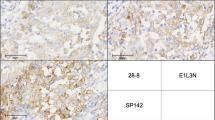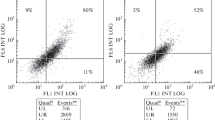Abstract
The MAGE-1 gene encodes a protein encompassing a HLA-A1-restricted target epitope for cytolytic T lymphocytes. Monoclonal antibodies directed against the MAGE-1 protein were tested for usage in immunohistology of routine pathology material. Seven formalinfixed, paraffin-embedded malignant melanomas were studied by the Avidin-Biotin complex (ABC) method with or without different antigen retrieval methods. Native, frozen tissues from the same tumours were used to validate the results by immunohistochemistry on frozen sections, by PCR for mRNA and by protein demonstration in tissue extracts using western blotting. Of 4 monoclonal antibodies tested, mAB 34B and mAB 77B were highly efficient in detecting MAGE-1 protein in deparaffinised sections with the regular ABC method after microwave pretreatment. In a series of an additional 28 patients 75% expressed MAGE-1, 50% in a substantial proportion. Follow-up studies in 6 patients indicate that the expression pattern remains stable but may change substantially within a short range. Immunohistology is thus a rapid and well-established method that might be used to select and monitor HLA-A1 positive patients with malignant melanoma and other candidate tumours for MAGE-1-directed immuno-therapy.
Similar content being viewed by others
References
Amar Costesec A, Godelaine D, Stockert E, Van der Bruggen P, Beaufay H, Chen YT (1994) The tumor protein MAGE-1 is located in the cytosol of human melanoma cells. Biochem Biophys Res Commun 204:710–715
Brasseur F, Marchand M, Vanwijck R, Herin M, Lethe B, Chomez P, Boon T (1992) Human gene MAGE-1, which codes for a tumor-rejection antigen, is expressed by some breast tumors (letter). Int J Cancer 52:839–841
Burrows SR, Fernan A, Argaet V, Suhrbier A (1993) Bystander apoptosis induced by CD8+ cytotoxic T cell (CTL) clones: implications for CTL lytic mechanisms. Int Immunol 5:1049–1058
Chomczynski P, Sacchi N (1987) Single-step method of RNA isolation by guadinium-thiocyanate-phenol-chloroform extraction. Anal Biochem 162:156–159
Inoue H, Mori M, Honda M, Li J, Shibuta K, Mimori K, Ueo H, Akiyoshi T (1995) The expression of tumor-rejection antigen “MAGE” genes in human gastric carcinoma. Gastroenterology 109:1522–1525
Lüscher U, Filgueira L, Juretic A, Zuber M, Lüscher NJ, Heberer M, Spagnoli GC (1994) The pattern of cytokine gene expression in freshly excised human metastatic melanoma suggests a state of reversible anergy of tumor-infiltrating lymphocytes. Int J Cancer 57:612–619
McLean I, Nakane PK (1974) Periodate-lysine-paraformaldehyde fixative — a new fixative for immunoelectron microscopy. J Histochem Cytochem 22:1077–1083
Moch H, Oberholzer M, Dalquen P, Wegmann W, Gudat F (1993) Diagnostic tools for differentiating between pleural mesothelioma and lung adenocarcinoma in paraffin embedded tissue. Part I: Immunohistochemical findings. Virchows Arch [A] 423:19–27
Oaks MK, Hanson JJ, O'Malley DP (1994) Molecular cytogenetic mapping of the human melanoma antigen (MAGE) gene family to chromosome region Xq27-qter: implications for MAGE immunotherapy. Cancer Res 54:1627–1629
Patard JJ, Brasseur F, Gil Diez S, Radvanyi F, Marchand M, Francois P, Abi Aad A, Van Cangh P, Abbou CC, Chopin D, et al (1995) Expression of MAGE genes in transitional-cell carcinomas of the urinary bladder. Int J Cancer 64:60–64
Rimoldi D, Romero P, Carrel S (1993) The human melanoma antigen-encoding gene, MAGE-1, is expressed by other tumour cells of neuroectodermal origin such as glioblastomas and neuroblastomas [letter]. Int J Cancer 54:527–528
Romero P, Pannetier C, Herman J, Jongeneel CV, Cerottini JC, Coulie PG (1995) Multiple specificities in the repertoire of a melanoma patient's cytolytic T lymphocytes directed against tumor antigen MAGE-1.A1. J Exp Med 182:1019–1028
Russo V, Traversari C, Verrecchia A, Mottolese M, Natali PG, Bordignon C (1995) Expression of the MAGE gene family in primary and metastatic human breast cancer: implications for tumor antigen-specific immunotherapy. Int J Cancer 64:216–221
Schultz-Thater E, Juretic A, Dellabona P, Lüscher U, Siegrist W, Harder F, Heberer M, Zuber M, Spagnoli GC (1994) MAGE-1 gene product is a cytoplasmic protein. Int J Cancer 59:435–439
Shichijo S, Hayashi A, Takamori S, Tsunosue R, Hoshino T, Sakata M, Kuramoto T, Oizumi K, Itoh K (1995) Detection of MAGE-4 protein in lung cancers. Int J Cancer 64:158–165
Shichijo S, Tsunosue R, Masuoka K, Natori H, Tamai M, Miyajima J, Sagawa K, Itoh K (1995) Expression of the MAGE gene family in human lymphocytic leukemia. Cancer Immunol Immunother 41:90–103
Toh Y, Yamana H, Shichijo S, Fujita H, Tou U, Sakaguchi M, Kakegawa T, Itoh K (1995) Expression of MAGE-1 gene by esophageal carcinomas. Jpn J Cancer Res 86:714–717
Traversari C, Van der Bruggen P, Luescher IF, Lurquin C, Chomez P, Van Pel A, De Plaen E, Amar-Costesec A, Boon T (1992) A nonapeptide encoded by human gene MAGE-1 is recognized on HLA-A1 by cytolytic T lymphocytes directed against tumor antigen MZ2-E. J Exp Med 176:1453–1457
Van der Bruggen P, Traversari C, Chomez P, Lurquin C, De Plaen E, Van den Eynde B, Knuth A, Boon T (1991) A gene encoding an antigen recognized by cytolytic T lymphocytes on a human melanoma. Science 254:1643–1647
Weynants P, Lethe B, Brasseur F, Marchand M, Boon T (1994) Expression of mage genes by non-small-cell lung carcinomas. Int J Cancer 56:826–829
Author information
Authors and Affiliations
Rights and permissions
About this article
Cite this article
Gudat, F., Dürmüller, U., Zuber, M. et al. The tumour-associated antigen MAGE-1 is detectable in formalin-fixed paraffin sections of malignant melanoma. Vichows Archiv A Pathol Anat 429, 77–81 (1996). https://doi.org/10.1007/BF00192428
Received:
Accepted:
Issue Date:
DOI: https://doi.org/10.1007/BF00192428




